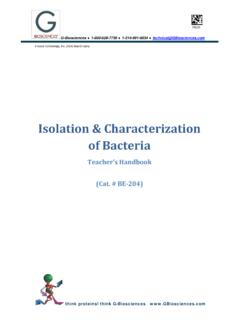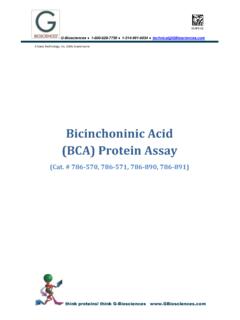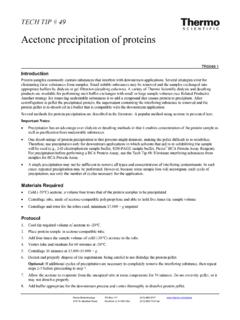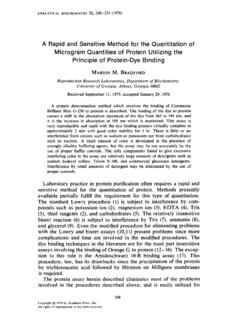Transcription of Plasmid Isolation (Alkaline Lysis) - G-Biosciences
1 G-Biosciences 1-800-628-7730 1-314-991-6034 A Geno Technology, Inc. (USA) brand name think proteins! think G-Biosciences PR047 Plasmid Isolation ( alkaline lysis ) Teacher s Guidebook (Cat. # BE-310) Page 2 of 12 MATERIALS INCLUDED .. 3 SPECIAL HANDLING INSTRUCTIONS .. 3 ADDITIONAL EQUIPMENT REQUIRED .. 3 TIME REQUIRED .. 3 OBJECTIVES .. 4 BACKGROUND .. 4 TEACHER S PRE EXPERIMENT SET UP .. 5 PREPARATION OF LB BROTH .. 5 PREPARE BACTERIAL STOCKS .. 5 5 VISUALIZATION OF PURIFIED PLASMIDS .. 6 MATERIALS FOR EACH GROUP .. 7 PROCEDURE .. 7 RESULTS, ANALYSIS & ASSESSMENT .. 9 MATERIALS INCLUDED This kit has enough materials and reagents for 24 students (six groups of four students). 1 vial Bac: Plasmid 1 Agar stab 1 vial LB Broth 2 bottles LB Broth 1 vial AMP (Ampicillin) 1 vial Sterile Water 1 bottle Cell Suspension Solution 1 bottle lysis Buffer 1 bottle Neutralization Buffer 1 vial TE Buffer 1 bottle precipitation Solution 50 Centrifuge Tubes ( ) SPECIAL HANDLING INSTRUCTIONS Store Plasmid 1 Agar Stab at 4 C Store AMP (Ampicillin) frozen until ready to use.
2 All other components can be stored at room temperature. Briefly centrifuge all small vials before opening to prevent waste of reagents. The majority of reagents and components supplied in the BioScience Excellence kits are non toxic and are safe to handle, however good laboratory procedures should be used at all times. This includes wearing lab coats, gloves and safety goggles. For further details on reagents please review the Material Safety Data Sheets (MSDS). The following items need to be used with particular caution. Part # Name Hazard 344P precipitation Solution Flammable ADDITIONAL EQUIPMENT REQUIRED 200-250ml Sterile Culture Flask Shaking Incubator Low speed centrifuge for tubes Culture Tubes (Optional) Agarose Electrophoresis Equipment and reagents TIME REQUIRED Day 1: 1-2 hours Page 3 of 12 OBJECTIVES Purify recombinant DNA plasmids from overnight culture.
3 Small scale Plasmid preparations. BACKGROUND A very common technique in molecular biology is commonly referred to as minipreps , which usually use an alkaline lysis method. Minipreps are used to isolate small quantities of DNA from bacterial colonies to screen colonies for the correct DNA Plasmid . Specific protocols for alkaline lysis differ from laboratory to laboratory, however they are all based on the same principal. The first stage is to grow the selected bacterial colonies in a small volume (3-5ml) of LB broth containing the selection antibiotic. The bacteria are pelleted and resuspended in a resuspension buffer. This buffer is often a basic pH Tris buffer, which helps to denature DNA, and EDTA (ethylenediaminetetraacetic acid) that binds divalent cations destabilizing the membrane and inhibiting DNases (enzymes that degrade DNA). In addition, RNases are also added to degrade the released RNA.
4 Next, the bacteria are lysed with strong alkali (Sodium Hydroxide (NaOH)) and detergent (Sodium Dodecyl Sulfate (SDS)). The SDS detergent solubilizes the phospholipids and proteins of the cell membrane resulting in cell lysis and the release of the cells contents. The high concentration of sodium hydroxide denatures the genomic and Plasmid DNA, as well as cellular proteins. The cellular DNA becomes linearized and the strands are separated, where as the Plasmid DNA is circular and remains topologically constrained (the two strands, although denatured remain together). Finally, a neutralization buffer of potassium acetate is added to neutralize the strong alkaline conditions. The addition of potassium acetate results in a high salt concentration that leads to the formation of a white precipitate that consists of SDS, lipids and proteins. In addition, the neutralization of the solution allows the renaturation of DNA.
5 The large chromosomal DNA is captured in the precipitate, where as the small Plasmid DNA remains in solution. The precipitate and chromosomal DNA is removed by centrifugation. Following centrifugation, the soluble Plasmid DNA can be purified from the solution by various techniques. The most common is to precipitate the DNA with alcohol (ethanol or isopropanol) or high salt (ammonium acetate, lithium chloride, sodium chloride or sodium acetate). Another method is to bind the DNA to a solid support, such as glass fibers or silica. At high salt concentration and neutral or low pH, DNA molecules have a high binding affinity for these supports, allowing for the easy capture and subsequent elution of the DNA. Page 4 of 12 This kit contains all the reagents necessary for the purification of Plasmid DNA by alkaline lysis and alcohol precipitation . TEACHER S PRE EXPERIMENT SET UP This kit can be used to purify plasmids from the colonies generated with the Bacterial Transformation kit (Cat.)
6 # BE-309). This kit contains enough reagents to allow each student to pick a single colony. If using colonies, then supply students with culture tubes (not supplied with this kit) containing 2ml LB Broth with ampicillin between the groups. Using aseptic techniques students pick colonies and grow them overnight at 37 C in a shaking incubator. The following day they begin the protocol at step 1. NOTE: Additional culture tubes and centrifuge tubes will be required. The purified plasmids can be further analyzed either by agarose gel electrophoresis or restriction digestion followed by agarose electrophoresis. We recommend using the Introduction to Agarose Electrophoresis kit (Cat. # BE-304) and the DNA Restriction Digestion Analysis kit (Cat. # BE-307). Preparation of LB Broth 1. Transfer the entire contents of the 2 bottles of LB Broth to a sterile 200-250ml culture flask.
7 2. Rehydrate the ampicillin by transferring 250 l sterile water to the vial of ampicillin. Dissolve the ampicillin by inverting the tube several times. 3. Using aseptic techniques, transfer 60 l ampicillin to the LB broth and swirl to mix. Prepare Bacterial Stocks 1. Add LB broth to the Plasmid 1 Agar stab and incubate at 37 C for 30minutes. 2. Vigorously shake or vortex for 1-2 minutes, then transfer LB broth from the agar stab to the 200-250ml culture flask containing LB Broth with ampicillin. 3. Incubate the vial at 37 C with shaking overnight. 4. The following day, supply the class with the overnight culture. OPTIONAL: 7ml overnight culture can be aliquoted into suitable tubes for each group. Miscellaneous 1. Prepare the DNA wash solution. Label a 15ml tube with DNA Wash . Transfer precipitation Solution and ultra pure water to the labeled tube. Invert 5-6 times to mix.
8 Page 5 of 12 2. Prior to commencement of the experiment, place the bottle of precipitation Solution in a freezer. Ice-cold precipitation Solution is needed for the optimal precipitation of Plasmid DNA. Visualization of Purified Plasmids 1. In order to visualize the purified plasmids products, an agarose gel will need to be run. Each student requires 1 well and additional wells are required for reference markers. You may use your own equipment and supplies or use G-Biosciences Introduction to Agarose Electrophoresis kit (Cat. # BE-304). Page 6 of 12 MATERIALS FOR EACH GROUP Supply each group with the following. Overnight Culture (Shared with class.) 8 Centrifuge tubes ( ) 1 bottle Cell Suspension Solution (shared with class) 1 bottle lysis Buffer (shared with class) 1 bottle Neutralization Buffer (shared with class) 1 bottle precipitation Solution (shared with class) 1 tube DNA Wash (shared with class) 1 vial TE buffer (shared with class) PROCEDURE 1.
9 Each student labels two Centrifuge tubes with his or her name. 2. Transfer overnight culture into labeled centrifuge tube. 3. Centrifuge at high speed for 3-5 minutes to pellet bacteria. Pour off the supernatant. 4. Add 200 l Cell Suspension Solution and mix the contents by flicking the tube or pipetting several times. This solution contains Tris (pH ), and EDTA (ethylenediaminetetraacetic acid). The basic pH helps to denature the DNA and the metal ion chelator, EDTA, stabilizes the cell membrane by binding the divalent cations of Mg2+ and Ca2+. RNase can also be added at this stage to degrade the RNA when the cells are lysed. 5. Incubate the vial on ice for 15 minutes. 6. Add 200 l lysis Buffer and mix the contents by gently inverting the tube 4-5 times. This solution contains sodium hydroxide and SDS (sodium dodecyl sulfate). The sodium hydroxide denatures the Plasmid and chromosomal DNA into single strands.
10 SDS, an ionic (charged) detergent dissolves the phospholipids in the membrane causing lysis and release of the bacteria contents, including the DNA, into the solution. 7. Add 200 l Neutralization Buffer and mix the contents by inverting the tube 4-5 times. This is a potassium acetate solution. The potassium acetate causes the precipitation of a SDS- protein complex as a white precipitate, consisting of SDS, lipids and proteins. In addition, the potassium acetate neutralizes the solution allowing the renaturation of the DNA. The large chromosomal DNA is captured in the precipitate, whereas the small Plasmid DNA remains in solution. Page 7 of 12 8. The tube is then centrifuged for 10 minutes at high speed (>5,000xg). 9. Transfer the clear liquid, or supernatant, to a fresh labeled tube. This can be stored for up to a week at 4 C. 10. Alcohol precipitation : To precipitate the Plasmid DNA, add 480 l ( volumes) precipitation Solution (isopropanol) to the supernatants from step 9.















